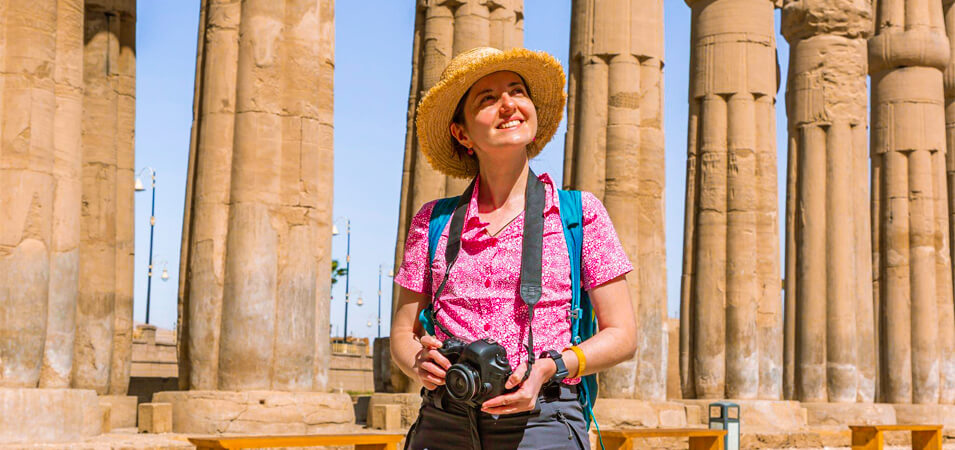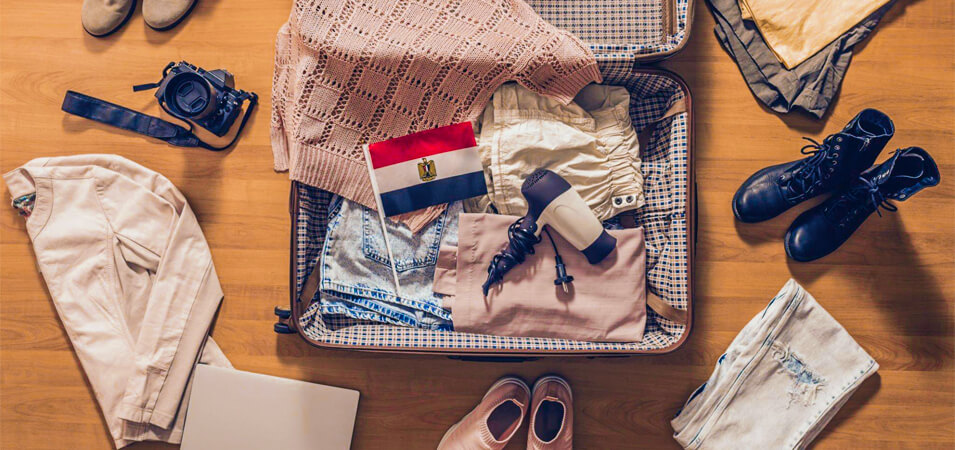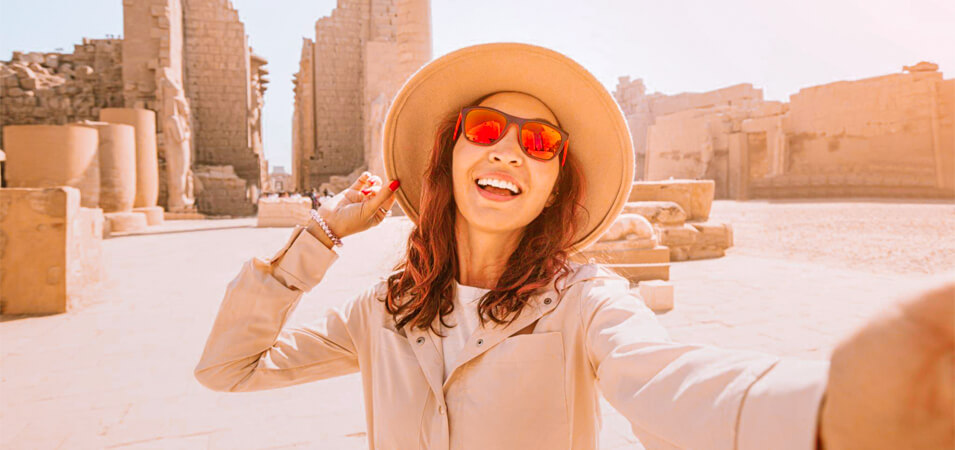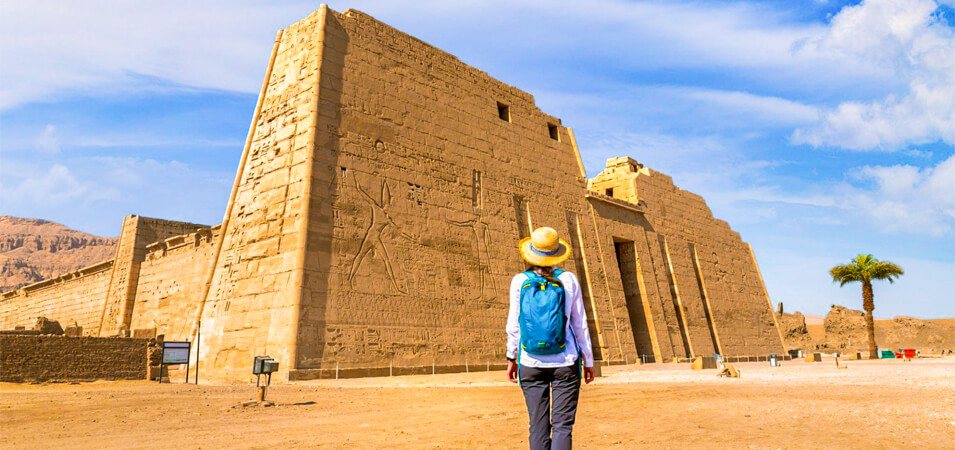When embarking on a journey to the mesmerizing land of Egypt, preparation is key to ensuring a seamless and enjoyable experience. Packing for your Egypt trip requires careful consideration, balancing the need for comfort and practicality with respect for the local culture. Start with the basics: lightweight, breathable clothing is essential, given Egypt’s often scorching temperatures.
Be sure to pack versatile pieces that can adapt to changing weather conditions and modest attire suitable for visits to religious sites. Footwear should prioritize comfort, as you’ll likely explore ancient ruins and bustling markets. Leaving space in your luggage for souvenirs is wise, as Egypt offers a treasure trove of unique gifts and keepsakes. Roll your clothing to save space to pack efficiently, and use packing cubes to organize your belongings.
Book Our Egypt Vacation Packages
Weather Considerations in Egypt
Understanding the weather in Egypt is crucial when planning your trip to this diverse and historically rich country. Egypt experiences a predominantly desert climate characterized by scorching summers and mild winters. During the summer months, from June to August, temperatures in cities like Cairo and Luxor can soar above 100°F (37°C), making it essential to pack lightweight, breathable clothing, sunblock, sunglasses, and a wide-brimmed hat to shield yourself from the intense sun.
The shoulder seasons, spring (March to May) and autumn (September to November) are considered the best times to visit Egypt, offering more moderate temperatures and pleasant weather for exploring its iconic landmarks. Winters, from December to February, are cooler but still comfortable, especially in southern areas. However, evenings can be chilly, so layering is recommended.

Clothing Recommendations for Different Seasons in Egypt
When it comes to dressing for the diverse seasons in Egypt, it’s crucial to adapt your wardrobe to the ever-changing weather conditions throughout the year. Egypt experiences a Mediterranean climate characterized by hot summers and mild winters. Here’s a breakdown of clothing recommendations for each season:
- Summer (June to August): Egypt’s summer is scorching hot, often exceeding 100°F (38°C). This season, lightweight, breathable fabrics like cotton and linen are your best friends. Opt for loose-fitting, light-colored clothing to stay cool. Sunscreen, sunglasses, and a wide-brimmed hat are essential to protect yourself from the intense sun.
- Autumn (September to November): As the scorching heat subsides, autumn in Egypt offers pleasant and milder weather. You can transition to long-sleeved shirts and light jackets for cooler evenings. However, days can still be warm, so layering is key. Neutral colors and natural fabrics maintain comfort while keeping you stylish.
- Winter (December to February): Winters in Egypt are relatively mild compared to other regions, but they can feel cool, especially at night. A light sweater or cardigan paired with jeans or slacks should suffice. You may need a heavier coat for the cooler evenings, and don’t forget a scarf to keep warm.
- Spring (March to May): Spring brings a gentle warmth back to the air, and the landscape blooms with vibrant colors. Embrace lightweight clothing, floral prints, and pastel colors. A light jacket or shawl for the evenings is still a good idea. Comfortable walking shoes are also essential for exploring Egypt’s natural beauty.
By following these clothing recommendations, you can enjoy Egypt’s stunning landscapes and cultural treasures comfortably throughout the year. Remember to stay hydrated and wear sunscreen, regardless of the season, to ensure a safe and enjoyable experience in this beautiful country.

Footwear: Comfortable and Practical Choices
When selecting the right footwear, comfort and practicality should be your top priorities. Your choice of shoes can greatly impact your overall well-being, so let’s explore the best options for each season:
- Summer: In summer’s scorching summer, breathable sandals or open-toed shoes are a godsend. Opt for lightweight materials like canvas or mesh that allow your feet to breathe. Look for cushioned insoles to provide comfort during long walks and ensure the soles provide good grip to prevent slipping on hot pavements.
- Autumn: As the temperatures start to cool down, it’s time to transition into closed-toe shoes. Comfortable sneakers or loafers are perfect for autumn. They offer support for your feet while keeping them warm during the mild chill of the season. Consider waterproof options for unexpected rain showers.
- Winter: When winter arrives with its cold and damp conditions, prioritize warmth and insulation. Invest in a good pair of waterproof boots with thermal lining to keep your feet cozy and dry. The soles should provide excellent traction to navigate icy sidewalks safely. Don’t forget to wear moisture-wicking socks to keep your feet dry and comfortable.
- Spring: Spring brings milder weather and the chance to embrace lighter footwear again. Slip-on shoes, like loafers or ballet flats, are excellent choices. They are easy to put on, provide comfort for walks in the blossoming nature, and are versatile for various outfits. Look for styles that have good arch support for added comfort.

Remember, the key to comfortable and practical footwear is finding the right balance between style and functionality. Choose shoes that suit your activities and the weather conditions you’ll be facing, and always prioritize the health and comfort of your feet. Your feet will thank you for it as you enjoy the different seasons with ease and style.
Sun Protection and Accessories
Protecting yourself from the sun’s harmful rays is essential for your skin’s health and overall well-being. To stay safe and stylish under the sun, consider these sun protection accessories:
- Wide-brimmed Hat: A wide-brimmed hat not only adds a touch of elegance to your ensemble but also provides shade for your face, neck, and shoulders. Look for hats made of lightweight, breathable materials like straw or cotton for comfort in the heat.
- Sunglasses: Invest in a quality pair of sunglasses that offer UV protection. Not only do they shield your eyes from the sun’s glare, but they also reduce the risk of eye damage and wrinkles caused by squinting.
- Sunscreen: Sunscreen is a must-have, regardless of the season. Choose a broad-spectrum sunscreen with a high SPF rating to protect your skin from harmful UVB and UVA rays. Remember to reapply every few hours, especially when spending extended time outdoors.
- Scarves and Shawls: Lightweight scarves and shawls are versatile accessories that can be draped over your shoulders or used as head coverings to protect against the sun’s intensity. They also add a stylish touch to your outfit.
- UV-Protective Clothing: Consider clothing made from UV-protective fabrics that offer an added layer of sun defense. These materials are designed to block UV radiation and keep you cool. Look for clothing items like swimwear, shirts, and pants with UPF (Ultraviolet Protection Factor) ratings.
- Umbrella: Carrying a compact, UV-blocking umbrella is a smart way to create your own shade when the sun is at its peak. It provides portable shelter and helps maintain your comfort during outdoor activities.
Incorporating these sun protection accessories into your daily routine allows you to enjoy the great outdoors without compromising your health and style. Remember that sun protection is not just a summer necessity; it’s a year-round commitment to maintaining your skin’s health and preventing long-term damage.

Essential Travel Documents and Money
Traveling to new destinations is an exciting adventure, but it’s crucial to ensure you have the necessary documents and financial arrangements in place for a smooth journey. Here are the essential travel documents and money-related tips to keep in mind:
- Passport: Your passport is your primary identification when traveling internationally. Ensure it’s valid for at least six months beyond your return date. Make copies of the identification page in a separate location in case your passport is lost or stolen.
- Visa: Check the visa requirements for your destination and obtain the necessary visas well in advance. Some countries offer visa-free entry or visa-on-arrival options, while others require extensive paperwork.
- Travel Insurance: Travel insurance covers unexpected events like trip cancellations, medical emergencies, or lost luggage. Protecting yourself and your finances during your journey is a wise investment.
- Itinerary and Reservation Confirmations: Keep a printed or digital copy of your travel itinerary, hotel reservations, and flight confirmations handy. This documentation can be useful for immigration and hotel check-ins.
- Driver’s License and International Driving Permit (IDP): If you plan to rent a car abroad, ensure you have your driver’s license and, if necessary, an International Driving Permit. Check the driving regulations of your destination.
- Vaccination and Health Records: Some countries require proof of vaccinations or health records. Verify if any vaccinations are needed for your trip and carry the necessary documents.
- Credit and Debit Cards: Notify your bank about your travel plans to avoid any issues with your credit or debit cards while abroad. Carry a mix of cards and some local currency for flexibility.
- Local Currency: Exchange some currency before your trip or withdraw cash from ATMs upon arrival to cover initial expenses like transportation and meals. Familiarize yourself with the local currency and exchange rates.
- Money Belt or Travel Wallet: Consider using a money belt or travel wallet to securely carry your passports, credit cards, and cash, especially in crowded or touristy areas.
- Emergency Contact Information: Have a list of emergency contacts, including local embassy or consulate details, saved in your phone and written down. Share your itinerary with a trusted friend or family member.
By ensuring you have these essential travel documents and money management strategies in place, you’ll be better prepared to navigate your journey with confidence and peace of mind. Traveling with the right documentation and financial preparations sets the stage for a memorable and worry-free adventure.

Electronics and Gadgets for Your Trip
Packaging the right electronics and gadgets in today’s digital age can enhance your travel experience and keep you connected. Here’s a checklist of essential electronics to consider for your trip:
- Smartphone: Your smartphone is a versatile travel companion. It serves as your camera, GPS, communication device, and more. Download travel apps, maps, and language translation tools to make navigating your destination easier.
- Portable Charger: A portable charger or power bank is a lifesaver for keeping your devices charged on the go, especially during long journeys or when outlets are scarce.
- Universal Adapter: Different countries have various plug types and voltages. A universal adapter ensures you can charge your devices anywhere in the world. Check the adapter’s compatibility with your electronics.
- Laptop or Tablet: A lightweight laptop or tablet can be useful if you need to work or stay connected during your trip. Ensure it’s secured in a padded case for protection.
- E-Reader: For avid readers, an e-reader like a Kindle or Nook takes up less space than physical books and allows you to carry a library with you.
- Noise-Canceling Headphones: Block out background noise on flights or in noisy environments with noise-canceling headphones. They also make long journeys more comfortable by providing high-quality sound.
- Camera: If photography is a passion, bring a digital camera or DSLR to capture high-quality images of your travels. Don’t forget extra memory cards and a protective case.
- Travel Adapter and Voltage Converter: If you have devices that are sensitive to voltage, consider a voltage converter in addition to your universal adapter to protect them from damage.
- Portable Wi-Fi Hotspot: Staying connected is easier with a portable Wi-Fi hotspot. You can rent one or purchase a local SIM card, depending on your destination.
- Headphone Splitter: If you’re traveling with a companion and want to share music or watch a movie together, a headphone splitter lets you both listen using the same device.
- Travel Surge Protector: Protect your electronics from power surges and provide extra outlets with a compact travel surge protector.
- External Hard Drive: Back up your photos and important documents using an external hard drive or cloud storage to prevent data loss.

Souvenir Shopping: Leaving Space in Your Luggage
One of the joys of traveling is collecting souvenirs to remember your journey, but planning and leaving space in your luggage for these cherished mementos is essential. Here are some tips on how to make room for your souvenirs without overpacking:
- Pack Light Initially: Start your trip with a well-organized, minimalistic luggage load. This will leave you with extra space for souvenirs and prevent the need for additional luggage or overweight baggage fees on your return journey.
- Choose Wisely: Be selective about the souvenirs you pick up. Focus on items that hold sentimental value or represent the essence of the destination. Avoid buying similar items from multiple places.
- Compact Souvenirs: Look for souvenirs that are compact and easy to pack, such as postcards, magnets, or small trinkets. These items occupy minimal space and can be a delightful reminder of your travels.
- Consider Practicality: Opt for souvenirs that serve a practical purpose, like clothing, accessories, or kitchenware. This way, you can enjoy your memento regularly rather than letting it collect dust on a shelf.
- Use Packing Cubes: Packing cubes can help you stay organized and maximize the use of available space in your luggage. Roll your clothes and use compression bags to create more room.
- Distribute Weight: Ensure an even weight distribution in your luggage. Place heavier items at the bottom and lighter, fragile souvenirs on top to prevent damage.
- Shipping Option: If you’ve bought large or fragile souvenirs that won’t fit in your luggage, consider shipping them home. Many destinations offer shipping services for tourists, saving you the hassle of carrying bulky items.
- Souvenir Bag: Carry a foldable, empty tote bag or duffel in your luggage to use as an additional souvenir bag on your return journey. This can be a convenient way to accommodate unexpected finds.
- Plan Ahead: Before your trip ends, take stock of your souvenirs and assess the available space in your luggage. This will help you avoid last-minute stress and ensure everything fits.
- Gift to Others: Consider gifting some of your souvenirs to friends or family who may appreciate them. This not only spreads the joy of your travels but also reduces the load in your luggage.
Leaving space in your luggage for souvenirs is a thoughtful way to commemorate your travels without the stress of overcrowded bags. By being mindful of what you collect and how you pack, you can strike the perfect balance between bringing home cherished memories and managing your luggage effectively.

Tips for Packing Efficiently
Packing efficiently can make your travel experience smoother and less stressful. Whether you’re going on a weekend getaway or a long international trip, these tips will help you maximize space, minimize wrinkles, and stay organized:
- Make a Packing List: Create a comprehensive packing list that includes all the essentials you’ll need for your trip. This list will serve as your guide and help you avoid overpacking.
- Choose the Right Luggage: Select luggage that suits your travel needs. A carry-on bag might suffice for shorter trips, while longer journeys may require a larger suitcase. Consider lightweight, durable options with wheels for ease of transport.
- Pack Versatile Clothing: Pack clothing that can be mixed and matched to create different outfits. Stick to a color palette that coordinates well, and opt for versatile pieces that can be dressed up or down.
- Roll, Don’t Fold: Rolling your clothes instead of folding them can save space and reduce wrinkles. This technique also allows you to see your clothing more easily when unpacking.
- Use Packing Cubes: Packing cubes help keep your clothes organized and separate items by category. They also compress clothing to maximize space. Use different cubes for tops, bottoms, and undergarments.
- Pack Shoes Efficiently: Place your shoes in shoe bags to prevent them from soiling your clothing. Fill the empty space inside your shoes with socks or small items to save room.
- Minimize Toiletries: Bring travel-sized toiletries or purchase essentials at your destination. Avoid carrying full-size products when smaller options are available.
- Know the Weather: Check the weather forecast for your destination and pack accordingly. This will prevent you from bringing unnecessary items like heavy coats in warm climates.
- Pack by Outfit: Plan your outfits in advance and pack complete outfits together. This reduces the likelihood of overpacking and makes getting dressed at your destination more convenient.
- Use Compression Bags: Compression bags can further reduce the volume of your clothing, especially if you have bulky items like jackets or sweaters.
- Limit Accessories: Be selective with accessories. Choose a few versatile pieces like scarves, hats, and jewelry that can enhance multiple outfits.
- Essentials in Carry-On: Keep essential items like medication, important documents, a change of clothes, and toiletries in your carry-on bag in case your checked luggage is delayed or lost.
- Digital Packing List: Consider using a digital packing list app or your smartphone’s notes app to create and manage your packing list. You can easily update and reuse lists for future trips.
- Leave Room for Souvenirs: If you plan to bring back souvenirs, leave some space in your luggage or bring an extra collapsible bag for the return journey.
Efficient packing saves you time and effort and ensures you have everything you need while traveling. Following these tips can streamline your packing process and enjoy a more organized and stress-free trip.

Conclusion
In conclusion, successful and enjoyable travel involves careful planning and consideration of various aspects, from choosing the right clothing for the seasons to packing efficiently and collecting meaningful souvenirs. Following the advice in this series of paragraphs can enhance your travel experiences and make the most of your journeys. From selecting comfortable and practical footwear to protecting yourself from the sun’s rays, from carrying essential travel documents and money to shopping for souvenirs that capture the spirit of your adventures, these tips and insights are designed to help you navigate the world with confidence, style, and ease. Whether you’re embarking on a weekend getaway or an extended international expedition, remember that travel is not just about the destination but also the journey and the memories you create along the way. Safe travels!
